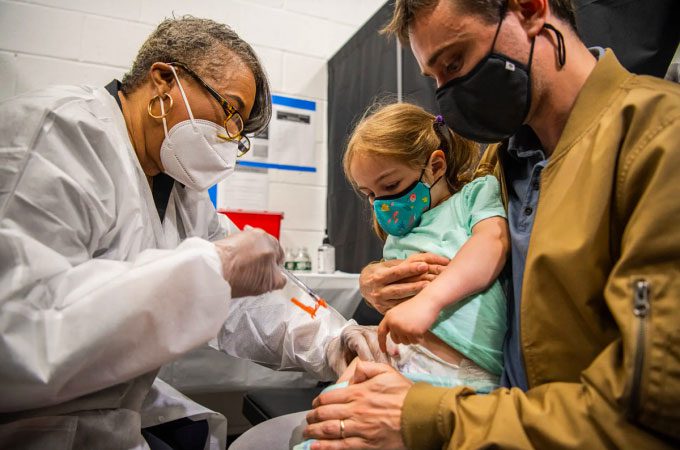Two new subvariants of Omicron, BA.4 and BA.5, are rapidly emerging due to their transmission advantages, vaccine-evading mutations, and waning immunity in certain regions.
After several weeks of decline, the number of Covid-19 infections and deaths has risen again globally. In countries such as Israel, Germany, and the United States, the prevalent variants in this new wave are BA.4 and BA.5. They are spreading vigorously due to their ability to transmit more quickly than other circulating variants, such as BA.2 (the “stealth” variant that caused a spike in cases earlier this year).
However, according to scientists, BA.4 and BA.5 cause fewer deaths and hospitalizations compared to the older versions of the virus—a sign that community immunity is increasing, keeping pace with the rise of Covid-19.
Why are these variants developing so quickly?
In May, scientists discovered that BA.4 and BA.5 share a common origin with previous Omicron strains. Analyses by evolutionary geneticists Bette Korber and William Fischer at the Los Alamos National Laboratory in the USA indicate that they could be a branch of BA.2.
The pair of variants shares more similarities with BA.2 than with BA.1, but they possess unique mutations, namely L452R and F486V in the spike protein. These mutations help the virus effectively attach to the host and evade the body’s immune response.
A study from Harvard Medical School published in the New England Journal of Medicine on June 22 also indicates that BA.4 and BA.5 appear to have the ability to evade antibodies in individuals who have previously contracted Covid-19, as well as those who have received booster shots. This increases the risk of breakthrough infections as immunity from vaccination and natural infection wanes over time.
The impact of BA.4 and BA.5 in different countries
According to Mr. Althaus, the scale of the BA.4 and BA.5 wave will vary by region. “It could be 5% in some countries and 30% in others. It all depends on the immunity status of the population,” he said.
Waasila Jassat, a public health expert at the National Institute for Communicable Diseases, noted that while the number of cases in South Africa is high, severe cases have only slightly increased during this new wave of infections.
Her upcoming research indicates that hospitalization rates during the BA.4 and BA.5 outbreaks are similar to those seen during the early Omicron wave, while mortality rates are somewhat lower.
However, countries outside of South Africa are experiencing greater impacts. In Portugal, where the Covid-19 vaccination rate is very high, levels of mortality and hospitalization are comparable to those during the first Omicron outbreak.
Dr. Althaus suggests that this may be due to demographic differences. South Africa has a younger population, while the average age in Europe is higher. “The more elderly individuals there are, the higher the number of severe cases,” he stated.
Another possible reason is community immunity, Dr. Jassat noted. About 50% of the adult population in South Africa has received two vaccine doses, with only 5% having received a booster. However, the prior rate of Covid-19 infections was very high, inadvertently creating a “hybrid immunity” wall that helps prevent severe disease, especially among older individuals.

A two-year-old girl receiving a Moderna vaccine in Times Square, USA, June 2022. (Photo: NY Times)
What’s next for Covid-19?
Laboratory studies show that antibodies from vaccines are less effective at preventing BA.4 and BA.5 infections. According to scientists, the virus can infect those who have received booster shots and even those with hybrid immunity (those who have been vaccinated and infected with the BA.1 Omicron variant). This is due to the L452R and F486V mutations that can evade immunity.
Scientists believe that the Omicron subvariants could further exploit gaps in existing community immunity.
“No one can confidently say that BA.4 and BA.5 are the final variants. It is very likely that other versions of Omicron will emerge,” said Kei Sato, a virologist at the University of Tokyo.
Researchers have identified regions in the virus’s spike protein that are not capable of evading antibodies from vaccines, but these will likely mutate in the future.
The next scenario could involve a new variant evolving from a different branch of the novel coronavirus, not Omicron. Reinfection with Omicron could lead the virus to mutate, creating a completely new variant that the immune response of patients may not recognize.
Increasingly, scientists believe that Omicron and Alpha may originate from individuals infected with the novel coronavirus for several months. During this time, mutations begin to recombine and adapt to achieve high transmissibility and evade immunity as effectively as possible.
According to Mahan Ghafari, a virology expert at the University of Oxford, for future virus strains to become widespread, they will likely need to evade immunity and possess many other concerning characteristics. Previously, Dr. Sato and colleagues found that BA.4 and BA.5 were more lethal in mice compared to BA.2. The two variants also infected laboratory-cultured lung cells more effectively.
While Dr. Jassat believes that Covid-19 will become milder over time, Dr. Sato warns that the community should not be complacent about this trend. “Not every virus becomes less severe after multiple evolutions, and it is unclear when a new variant will emerge,” Dr. Sato stated.
BA.4 and BA.5 were reported in South Africa just a few months after BA.1 and BA.2—this pattern is repeating in many places such as the United States and the United Kingdom. As the world achieves sufficient immunity, Dr. Althaus hopes that the frequency of Covid-19 waves will slow down.
“Another possibility is that the pandemic evolves into a seasonal illness, peaking in winter, waning, and returning every two to three years or longer,” Althaus noted.



















































